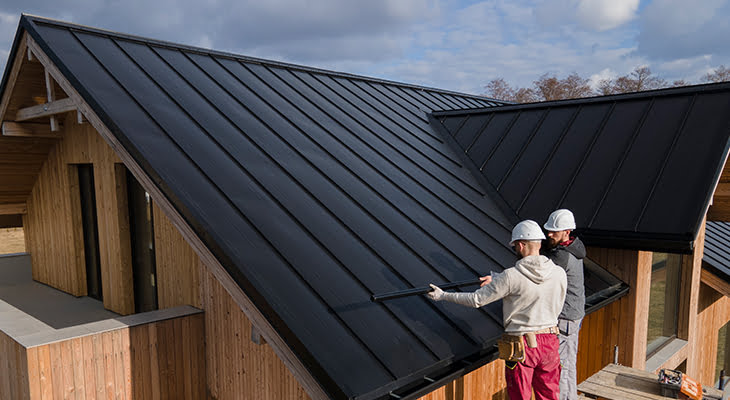
Choosing to install a metal roof on your home is a significant decision that promises durability, energy efficiency, and aesthetic appeal. However, understanding the process of residential metal roof installation can help homeowners feel more prepared and confident.
This comprehensive blog will walk you through what to expect during the installation of residential metal roofing, by expert residential roofers ensuring you are well-informed every step of the way.
Initial Consultation And Planning
The installation process begins with a detailed consultation and planning phase. During this time, a professional roofing contractor will assess your current roof, discuss your needs and preferences, and provide recommendations.
This phase is crucial as it sets the foundation for the entire project. You’ll discuss material options, colour choices, and other design elements. Additionally, the contractor will provide a timeline and cost estimate, allowing you to plan accordingly.
Site Preparation
Before the actual installation can begin, the site must be prepared. This involves several key steps:
- Removing The Old Roof: In many cases, the existing roof must be removed. This ensures a clean and solid base for the new metal roof.
- Inspecting The Roof Deck: The roof deck, or the surface that supports the roofing material, is inspected for any damage or rot. Any necessary repairs are made to ensure the deck is in optimal condition.
- Protective Measures: Surrounding areas, such as landscaping and exterior walls, are protected to prevent any damage during the installation process.
Installation Of Underlayment
The underlayment is a critical component of a metal roofing system. It acts as a secondary barrier against water infiltration. The installation process includes:
- Choosing The Right Underlayment: There are different types of underlayment available, including synthetic and felt. Your contractor will help you choose the best option based on your specific needs.
- Proper Installation: The underlayment is installed over the entire roof deck, providing an extra layer of protection. This step is vital for the overall performance and longevity of your metal roof.
Installing The Metal Panels
With the underlayment in place, the next step is to install the metal panels. This process is meticulous and requires professional expertise:
- Measuring And Cutting Panels: Metal panels are measured and cut to fit your roof’s dimensions precisely. Accurate measurements ensure a seamless and secure fit.
- Fastening The Panels: The panels are secured to the roof deck using specialized fasteners. Proper fastening is crucial to withstand various weather conditions and ensure the panels remain intact.
- Sealing The Joints: Sealing the joints between panels prevents water from seeping through. High-quality sealants are used to ensure a watertight seal.
Installation Of Flashing And Trim
Flashing and trim are essential elements that protect vulnerable areas of the roof, such as valleys, edges, and penetrations. The residential metal roofing installation process involves:
- Flashing Installation: Flashing is installed around roof features like chimneys, vents, and skylights. This prevents water from entering these areas.
- Adding Trim: Trim pieces are added to the edges and ridges of the roof. These not only enhance the roof’s appearance but also provide additional protection against the elements.
Ventilation System
Proper ventilation is vital for the longevity of your metal roof and the overall health of your home. The installation process includes:
- Assessing Ventilation Needs: Your contractor will evaluate your home’s ventilation needs and recommend the best system.
- Installing Vents: Ridge vents, soffit vents, or other ventilation systems are installed to ensure proper airflow. This helps regulate temperature and prevent moisture buildup in the attic.
Final Inspection And Cleanup
Once the installation is complete, a thorough inspection is conducted to ensure everything is in place and functioning correctly:
- Quality Check: The contractor will inspect the roof for any issues, ensuring that all panels, flashing, and trim are securely installed.
- Cleanup: The site is cleaned, and all debris is removed. This includes any leftover materials and tools, leaving your property clean and safe.
Maintenance Tips
After the installation, maintaining your metal roof is essential to ensure its longevity and performance. Here are some maintenance tips:
- Regular Inspections: Schedule regular inspections to identify and address any issues early.
- Cleaning The Roof: Keep the roof clean by removing debris, leaves, and dirt. This prevents water buildup and potential damage.
- Gutter Maintenance: Ensure gutters are clean and free of debris to allow proper drainage.
Also Read: Top 10 Maintenance Mistakes To Avoid With Your Metal Roof
About Stahl Roof Systems
Stahl Roof Systems is a leading provider of high-quality metal roofing solutions, specializing in residential and commercial installations. With a commitment to excellence, we offer durable and aesthetically pleasing roofing systems tailored to meet the unique needs of each client. Our team of experienced professionals ensures seamless installation and unparalleled customer service. For more information, contact us today.
